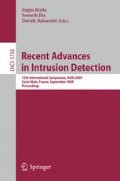Abstract
In order to detect a compromise of a running process based on it deviating from its program’s normal system-call behavior, an anomaly detector must first be trained with traces of system calls made by the program when provided clean inputs. When a patch for the monitored program is released, however, the system call behavior of the new version might differ from that of the version it replaces, rendering the anomaly detector too inaccurate for monitoring the new version. In this paper we explore an alternative to collecting traces of the new program version in a clean environment (which may take effort to set up), namely adapting the anomaly detector to accommodate the differences between the old and new program versions. We demonstrate that this adaptation is feasible for such an anomaly detector, given the output of a state-of-the-art binary difference analyzer. Our analysis includes both proofs of properties of the adapted detector, and empirical evaluation of adapted detectors based on four software case studies.
Access this chapter
Tax calculation will be finalised at checkout
Purchases are for personal use only
Preview
Unable to display preview. Download preview PDF.
References
Aho, A.V., Sethi, R., Ullman, J.D.: Compilers: Principles, Techniques, and Tools. Addison-Wesley, Reading (1986)
Basu, S., Uppuluri, P.: Proxi-annotated control flow graphs: Deterministic context-sensitive monitoring for intrusion detection, pp. 353–362. Springer, Heidelberg (2004)
Buchanan, E., Roemer, R., Schacham, H., Savage, S.: When good instructions go bad: Generalizing return-oriented programming to RISC. In: Proceedings of the 15th ACM Conference on Computer and Communications Security (October 2008)
Cohn, R.S., Goodwin, D.W., Lowney, P.G.: Optimizing Alpha executables on Windows NT with Spike. Digital Tech. J. 9, 3–20 (1998)
Feng, H., Giffin, J., Huang, Y., Jha, S., Lee, W., Miller, B.: Formalizing sensitivity in static analysis for intrusion detection. In: Proceedings of the 2004 IEEE Symposium on Security and Privacy (May 2004)
Feng, H., Kolesnikov, O., Fogla, P., Lee, W., Gong, W.: Anomaly detection using call stack information. In: Proceedings of the 2003 IEEE Symposium on Security and Privacy, May 2003, pp. 62–75 (2003)
Forrest, S., Hofmeyr, S., Somayaji, A., Longstaff, T.: A sense of self for Unix processes. In: Proceedings of the 1996 IEEE Symposium on Security and Privacy, May 1996, pp. 120–128 (1996)
Gao, D., Reiter, M.K., Song, D.: Gray-box extraction of execution graph for anomaly detection. In: Proceedings of the 11th ACM Conference on Computer & Communication Security (CCS 2004) (2004)
Gao, D., Reiter, M.K., Song, D.: On gray-box program tracking for anomaly detection. In: Proceedings of the 13th USENIX Security Symposium (2004)
Gao, D., Reiter, M.K., Song, D.: BinHunt: Automatically finding semantic differences in binary programs. In: Chen, L., Ryan, M.D., Wang, G. (eds.) ICICS 2008. LNCS, vol. 5308, pp. 238–255. Springer, Heidelberg (2008)
Giffin, J., Jha, S., Miller, B.: Detecting manipulated remote call streams. In: Proceedings of the 11th USENIX Security Symposium (August 2002)
Giffin, J., Jha, S., Miller, B.: Efficient context-sensitive intrusion detection. In: Proceedings of the ISOC Symposium on Network and Distributed System Security (February 2004)
Gopalakkrishna, R., Spafford, E.H., Vitek, J.: Efficient intrusion detection using automaton inlining. In: Proceedings of the 2005 Symposium on Security and Privacy, pp. 18–31 (2005)
Hofmeyr, S.A., Forrest, S., Somayaji, A.: Intrusion detection using sequences of system calls. Journal of Computer Security, 151–180 (1998)
Sekar, R., Bendre, M., Dhurjati, D., Bollineni, P.: A fast automaton-based method for detecting anomalous program behaviors. In: Proceedings of the 2001 IEEE Symposium on Security and Privacy, May 2001, pp. 144–155 (2001)
Tan, K., Maxion, R.: “Why 6?”– Defining the operational limits of stide, an anomaly-based intrusion detector. In: Proceedings of the 2002 IEEE Symposium on Security and Privacy, May 2002, pp. 188–201 (2002)
Tan, K., McHugh, J., Killourhy, K.: Hiding intrusions: From the abnormal to the normal and beyond. In: Petitcolas, F.A.P. (ed.) IH 2002. LNCS, vol. 2578, pp. 1–17. Springer, Heidelberg (2003)
Wagner, D., Dean, D.: Intrusion detection via static analysis. In: Proceedings of the 2001 IEEE Symposium on Security and Privacy (May 2001)
Wagner, D., Soto, P.: Mimicry attacks on host-based intrusion detection systems. In: Proceedings of the 9th ACM Conference on Computer and Communications Security (2002)
Wang, Z., Piece, K., Mcfarling, S.: BMAT – a binary matching tool for stale profile propagation. The Journal of Instruction-Level Parallelism 2(2000) (2000)
Author information
Authors and Affiliations
Editor information
Editors and Affiliations
Rights and permissions
Copyright information
© 2009 Springer-Verlag Berlin Heidelberg
About this paper
Cite this paper
Li, P., Gao, D., Reiter, M.K. (2009). Automatically Adapting a Trained Anomaly Detector to Software Patches. In: Kirda, E., Jha, S., Balzarotti, D. (eds) Recent Advances in Intrusion Detection. RAID 2009. Lecture Notes in Computer Science, vol 5758. Springer, Berlin, Heidelberg. https://doi.org/10.1007/978-3-642-04342-0_8
Download citation
DOI: https://doi.org/10.1007/978-3-642-04342-0_8
Publisher Name: Springer, Berlin, Heidelberg
Print ISBN: 978-3-642-04341-3
Online ISBN: 978-3-642-04342-0
eBook Packages: Computer ScienceComputer Science (R0)

